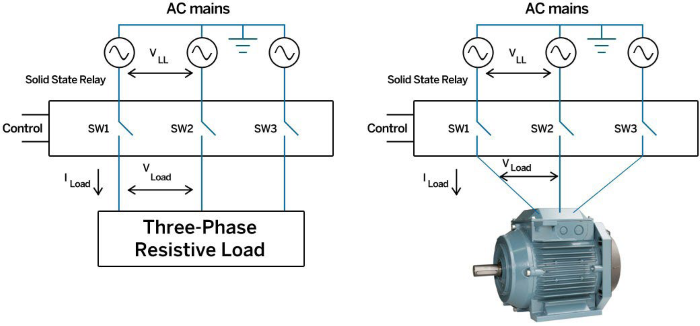Three-phase solid state relays (SSRs) have been available not long after single-phase SSRs were introduced in 1970. These relays' first iteration comprised three individual SSRs packaged in a single housing with a common input connection. This basic design concept remains mostly the same today. However, while the functions of single-phase and three-phase relays are broadly similar, their application usage can vary considerably. This is mainly due to the individual features of three-phase power circuits and the characteristics/demands of three-phase loads, especially inductive loads.
Therefore, knowing how to select and apply three-phase SSRs for motor control applications requires a deep knowledge of three-phase SSRs and a comprehensive understanding of the three-phase power system and typical loads.
This article outlines a review of three-phase power systems, the characteristics of common three-phase motor loads, and a detailed discussion of three-phase SSRs and their application relating to such loads.
SSRs are typically employed across various electrical load-switching applications, including professional cooking equipment, laboratory ovens, beverage dispensing equipment, medical equipment, plastics machinery, packaging machinery, lighting systems, HVAC&R systems, and many other industrial or commercial applications.
However, to fully understand these applications in relation to the use of SSRs for their control, most loads can be categorized into two primary groups: heating and motion control. This is far from an all-inclusive grouping because there are other applications beyond the scope of these two categories, including lighting and power distribution systems. However, most design engineers specifying SSRs apply them to one of these two general types of three-phase loads, as shown in Figure 1 below. The focus here is on motor loads, while a companion paper focuses on heating loads.

Figure 1. Block diagram depicting three-phase loads controlled by Three-phase SSRs. Image Credit: Sensata Technologies, Inc.
While every application is unique and requires scrutiny, focusing on these two main categories permits generalizations about their characteristics and the consequent requirements that SSRs must fulfill to perform the various switching functions for each category.
A limited focus on higher-power systems using three-phase networks to energize the load(s) does not exclude an evaluation of some of the most challenging commercial and industrial applications where SSRs are employed today.

This information has been sourced, reviewed and adapted from materials provided by Sensata Technologies, Inc.
For more information on this source, please visit Sensata Technologies, Inc.